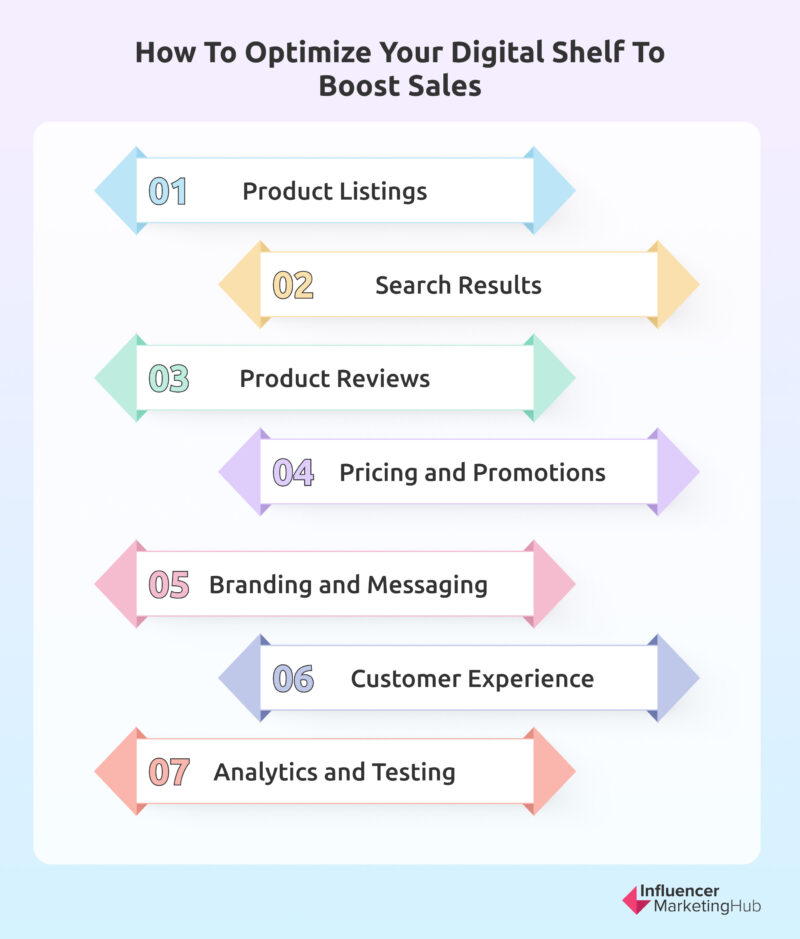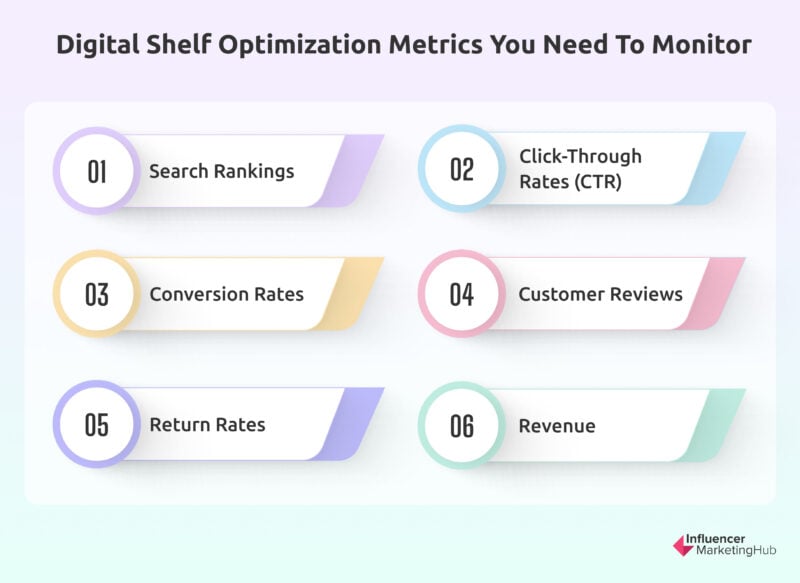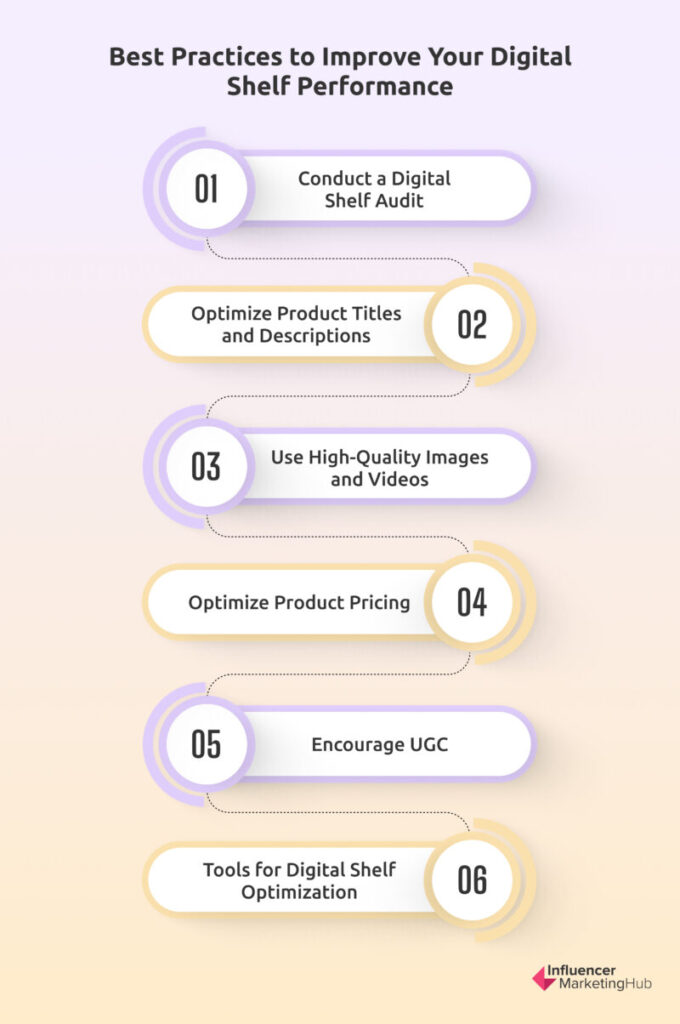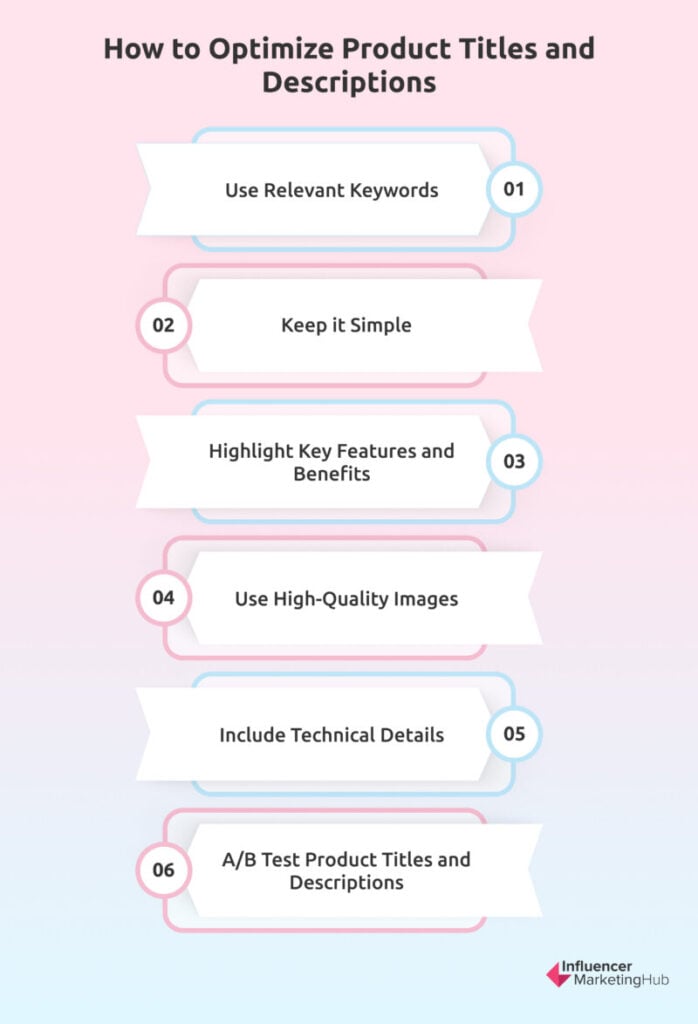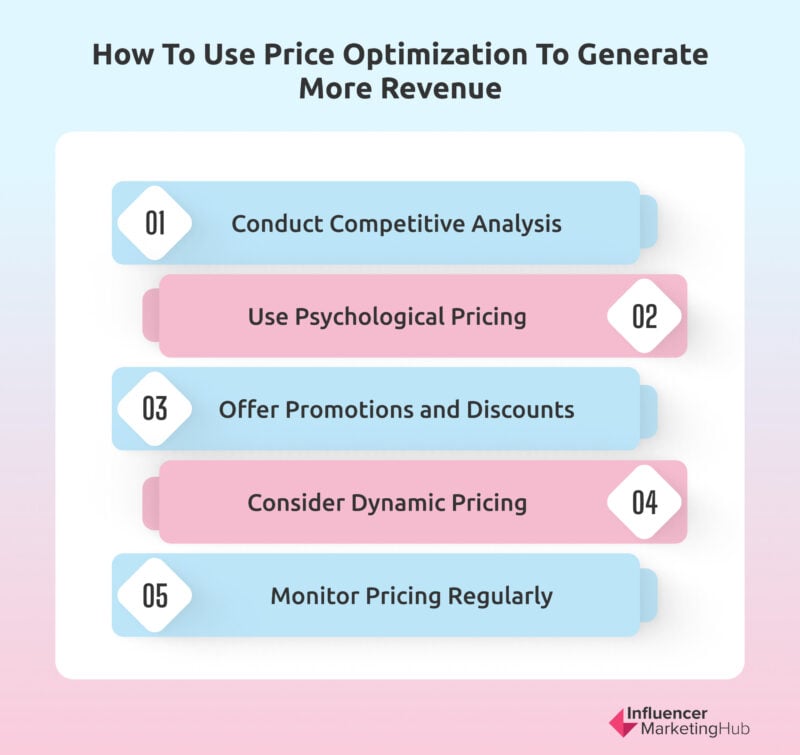As more and more consumers turn to online shopping, businesses are realizing that the competition for their attention has shifted from physical shelves to digital ones. In fact, 2.64 million people worldwide, which make up 33.33% of the population in 2023, are already doing their shopping online. This means that businesses are focusing on strengthening their online presence in order to enhance sales, improve brand engagement, and build a loyal consumer base.
But what exactly is the "digital shelf"? Simply put, it's the virtual space where consumers browse and make purchasing decisions on e-commerce websites. And just like in physical stores, brands are fighting for visibility and sales on these digital shelves. In fact, appearing beyond the first page is like being lost in the Bermuda Triangle of e-commerce - hardly anyone will find you! Studies have shown that the first three products on major retailers' search engines get as much as 80% of clicks. So, if you want your product to stand out like a star on the digital shelf, you need to aim for those top spots.
But how can brands achieve that top spot? The answer is optimization. Just like you might optimize your website for search engines, brands need to optimize their product listings for the algorithms that power e-commerce websites. This is where Digital Shelf Optimization (DSO) comes in. It's a vital part of e-commerce as having a strong presence on the digital shelf is key for brands to stand out and drive sales.
In this guide, we'll explore how DSO can help brands achieve their business goals and present tips on how you can optimize your own digital shelf. Whether you're a small business just starting out or a well-established brand, understanding the importance of the digital shelf is crucial in today's online marketplace.
A Complete Guide to Digital Shelf Optimization for Ecommerce Brands:
- What is Digital Shelf?
- What is Digital Shelf Optimization
- Why is Digital Shelf Optimization Important?
- What is Digital Shelf Analytics?
- Digital Shelf Optimization Components
- Key Metrics for Digital Shelf Optimization
- Best Practices for Digital Shelf Optimization
- How Can DSO Help Companies Boost Their Sales?
- Frequently Asked Questions
Understanding Digital Shelf Optimization
If you are looking to succeed in the cutthroat world of e-commerce, now it's the perfect time to start optimizing your digital shelf presence. Let’s dive in.
What is Digital Shelf?
The digital shelf is like a virtual aisle where shoppers can browse and purchase products online. It's a space where brands compete for attention and sales, just like they would in a physical store. But instead of shelves, products are listed on e-commerce websites like Amazon, Walmart, and Target.
So, what exactly is the digital shelf? It's the collection of all the digital touchpoints where consumers can interact with a brand's products. This includes everything from search results and product pages to social media and online ads.
The digital shelf is becoming increasingly important for brands as more and more consumers turn to online shopping. In fact, by 2026, e-commerce sales are projected to reach a staggering $8.1 trillion worldwide.
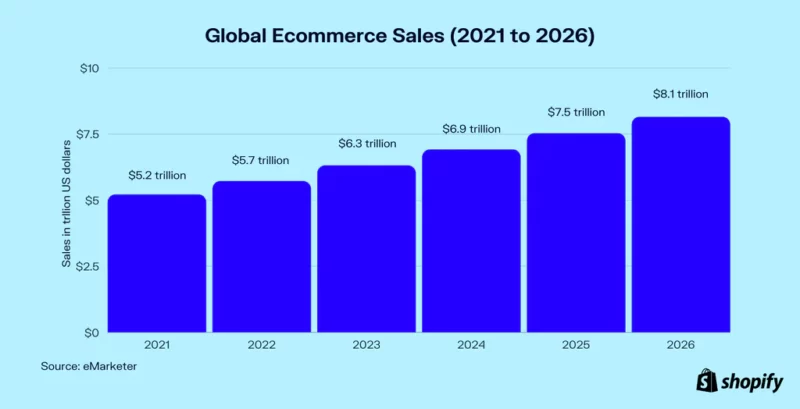
Source: shopify.com
But simply having a presence on the digital shelf isn't enough. Brands need to optimize their listings to stand out in the crowded digital marketplace. This means using relevant keywords, providing high-quality product images and videos, and offering competitive pricing and shipping options.
So, to sum it up, the digital shelf is the virtual storefront where brands can reach and engage customers online. By optimizing their product listings and creating a seamless digital experience, brands can stand out in the crowded digital marketplace and drive sales.
What is Digital Shelf Optimization
Digital shelf optimization is the art of crafting and optimizing a brand's presence on the virtual shelves of e-commerce websites. It involves using a range of tactics and strategies to ensure that a brand's products are visible, compelling, and easy to find and purchase.
One of the key components of digital shelf optimization is search engine optimization (SEO). This involves using relevant keywords in product titles and descriptions to improve a brand's visibility in search results.
But digital shelf optimization isn't just about technical details like SEO. It's also about creating a compelling brand narrative and crafting messaging that resonates with consumers. Storytelling can be a powerful tool in this regard, allowing brands to connect with consumers on an emotional level and differentiate themselves from the competition.
Another important component of digital shelf optimization is product content. This includes everything from product descriptions and images to videos and customer reviews. Optimizing product content can help improve a brand's visibility, build trust and credibility with consumers, and ultimately drive sales.
But perhaps the most important aspect of digital shelf optimization is the overall customer experience. Brands that invest in creating a seamless and enjoyable shopping experience for their customers are more likely to drive sales and build brand loyalty. This includes factors like website design, ease of navigation, personalized recommendations, and customer support.
Why is Digital Shelf Optimization Important?
A digital shelf is defined as where and how products are shown online, allowing customers to browse, find, compare, and buy products from a variety of businesses. It’s where the digital shopper interacts with your products, ranging from search engine platforms like Google and Bing to online marketplaces like Amazon, Walmart, and Target. It also includes your own website, social media sites, reviews sites, category pages, and product pages.
Just like on a grocery shelf, you’d want your products to be the most visible they can be to catch the eye of those potential customers. DSO is especially important because it influences whether or not a product can be found during a digital shopper's purchasing journey. It allows businesses to advertise their goods to consumers at several points in the buying process with the goal of increasing sales.
The evolution of the customer journey is another important factor in why DSO is so necessary. How customers used to progress on their customer journey, moving from interest to research and consideration to converting and making a purchase, isn’t as linear as it used to be. Google refers to this non-linear path in the "messy middle", which recognizes that there are several distractions that can happen between triggering an interest in the product and the actual purchase.
By improving the quality of your online content, DSO can enhance traffic to your pages while maintaining customer interest. While there are several strategies to generate traffic, an organic search may be the most crucial tool because it enables you to appear naturally at the top of searches or your selected category on a retailer's website.
Optimization can also be achieved more easily with DSO solutions such as Pacvue, which aims to improve the e-commerce presence of brands. The Pacvue platform allows you to drive more sales from different online marketplaces, using DSO to drive performance across all your marketing touchpoints. It lets you manage digital shelf components such as inventory, pricing, page content, and online advertising all in one place, ensuring your optimization efforts are also maximized.
What is Digital Shelf Analytics?
If the digital shelf covers the entire customer journey online, then digital shelf analytics (DSA) focuses only on product page metrics. To be more specific, DSA measures and tracks how a product or page performs online. It uses KPIs that determine whether your business goals are met and provides insights into how to improve performance if those goals fall short. This is done by gathering and analyzing the performance metrics of the product pages throughout the customer’s purchase journey.
DSA isn’t just a process of monitoring metrics—these analytics give you information so you can make informed decisions and optimize your digital shelf by understanding what areas require improvement and where you are performing well.
Digital Shelf Optimization Components
Think of digital shelf optimization as a game of chess - it's a strategic approach that requires careful planning and execution. Just as a skilled chess player considers every move and considers the strengths and weaknesses of their opponent, brands must also carefully consider each of the following component of their digital shelf strategy:
- Product Listings - This is where customers can view and learn about the products that a brand is selling. Optimizing product listings is essential to driving sales on the digital shelf.
- Search Results - This is the list of products that appears when a customer performs a search on an e-commerce website. Brands can improve their visibility in search results by using relevant keywords and optimizing their product listings.
- Product Reviews - Reviews are a powerful tool for building trust and credibility on the digital shelf. Encouraging customers to leave reviews can help boost a brand's reputation and drive sales.
- Pricing and Promotions - Price is a major factor in purchasing decisions on the digital shelf. Brands that offer competitive pricing and promotions are more likely to attract customers and drive sales.
- Branding and Messaging - A brand's overall message and tone of voice can help differentiate it from the competition and build brand loyalty. For example, a brand selling luxury skincare products might use elegant and sophisticated messaging to appeal to its target audience.
- Customer Experience - The digital shelf is all about creating a seamless and enjoyable shopping experience for customers. This includes everything from website design and navigation to personalized recommendations and customer support.
- Analytics and Testing - Analytics and testing are essential components of digital shelf optimization. Brands that track their performance and make data-driven decisions are more likely to see success on the digital shelf.
Key Metrics for Digital Shelf Optimization
If a brand's digital shelf strategy is working, they need to track and analyze key metrics.
Here are some of the key metrics for digital shelf optimization:
- Search Rankings - This metric measures a brand's visibility in search results on e-commerce websites. Brands that rank higher in search results are more likely to attract clicks and drive sales.
- Click-Through Rates (CTR) - This is the percentage of people who click on a brand's product listing after seeing it in search results. Brands with higher CTRs are more likely to drive sales.
- Conversion Rates - Conversion rates measure the percentage of website visitors who make a purchase. Higher conversion rates indicate that brands are more effective at turning website visitors into customers.
- Customer Reviews - Reviews are a powerful tool for building trust and credibility on the digital shelf. Brands with higher numbers of positive reviews are more likely to attract new customers and drive sales.
- Return Rates - This metric measures the percentage of customers who return a product after purchasing it. If there is an increase in this metric, brands may need to improve their product listings or customer experience to reduce returns.
- Revenue - Revenue measures the total amount of money a brand generates from online sales. Brands that focus on optimizing their digital shelf presence are more likely to see increases in revenue.
Best Practices for Digital Shelf Optimization
It’s pretty clear by now that digital shelf optimization is a multi-faceted approach to improving a brand's presence on e-commerce websites. While there is no one-size-fits-all approach, there are some best practices that brands can follow to improve their chances of success.
Conduct a Digital Shelf Audit
Conducting a digital shelf audit is an essential component of digital shelf optimization. It involves analyzing a brand's presence on e-commerce websites to identify areas for improvement and make data-driven decisions to improve performance.
Here are the key steps involved in conducting a digital shelf audit:
- Analyze Product Listings - Start by analyzing your product listings on e-commerce websites. Are your product titles and descriptions optimized with relevant keywords? Do your product images accurately represent your products? Is your pricing and promotional strategy competitive?
- Check Customer Reviews - Customer reviews are a powerful tool for building trust and credibility on the digital shelf. Analyze your customer reviews to identify common complaints or issues, and use this information to improve your product listings or customer experience.
- Evaluate Competitors - Conduct a competitive analysis to see how your products and pricing compare to the competition. Identify areas where you can differentiate yourself and improve your overall performance on the digital shelf.
- Analyze Analytics - Use analytics to track your performance on e-commerce websites. Are you seeing high click-through rates and conversion rates? Are your products showing up in relevant search results? Use this information to make data-driven decisions and improve your overall performance.
- Make Data-Driven Decisions - Based on your analysis, make data-driven decisions to improve your digital shelf strategy. This may include optimizing product listings, adjusting pricing or promotional strategy, or improving the customer experience.
According to a study by Salsify, brands that conduct regular digital shelf audits see a 150% increase in online sales. This is because audits help brands identify areas for improvement and make data-driven decisions that improve their overall performance on the digital shelf.
Optimize Product Titles and Descriptions
Product titles and descriptions are one of the most important aspects of a brand's presence on the digital shelf. They play a crucial role in improving a brand's visibility in search results and attracting customers to click on their products. Here are some best practices for optimizing product titles and descriptions:
- Use Relevant Keywords - Using relevant keywords in product titles and descriptions is essential for improving a brand's visibility in search results. Brands should conduct keyword research to identify the most relevant keywords for their products.
- Keep it Simple - Product titles and descriptions should be concise and to the point. Avoid using complex language or industry jargon that may confuse or turn off potential customers.
- Highlight Key Features and Benefits - Product descriptions should highlight the key features and benefits of the product. This information can help customers make informed purchasing decisions and improve overall customer satisfaction.
- Use High-Quality Images - High-quality images are an essential component of product listings. Brands should use images that accurately represent their products and provide customers with a clear idea of what they are purchasing.
- Include Technical Details - Technical details, such as product dimensions or materials, should be included in product listings to provide customers with a comprehensive understanding of the product.
- A/B Test Product Titles and Descriptions - A/B testing can help brands identify which product titles and descriptions are most effective at driving clicks and conversions. Brands should experiment with different titles and descriptions and use data to make data-driven decisions.
Use High-Quality Images and Videos
High-quality images and videos are crucial for digital shelf optimization. They help customers visualize products, improve overall customer satisfaction, and increase the likelihood of a purchase. Here are some best practices for using high-quality images and videos:
- Use High-Quality Images - High-quality images are essential for creating a positive customer experience on the digital shelf. Brands should use images that accurately represent their products and show them from multiple angles to give customers a clear idea of what they are purchasing.
- Use Videos to Showcase Products - Videos are a powerful tool for showcasing products and demonstrating their features and benefits. Brands should use videos to give customers a comprehensive understanding of their products and how they can be used.
- Optimize Images and Videos for Speed - Slow-loading images and videos can negatively impact the customer experience and lead to higher bounce rates. Brands should optimize their images and videos for speed to ensure they load quickly and provide a seamless shopping experience.
- Use Consistent Imagery - Consistent imagery across product listings can help build brand recognition and improve overall customer satisfaction. Brands should use consistent backgrounds, lighting, and positioning across their product images and videos.
- Use Alt Text - Alt text is an important component of accessibility and can help improve a brand's visibility in search results. Brands should use descriptive alt text to describe their product images and videos.
Optimize Product Pricing
Pricing is a crucial component of digital shelf optimization. It can greatly impact a brand's visibility in search results, customer perception, and overall sales. Here are some best practices for optimizing product pricing:
- Conduct Competitive Analysis - Start by conducting a competitive analysis to see how your pricing compares to the competition. Identify areas where you can differentiate yourself and offer competitive pricing.
- Use Psychological Pricing - Psychological pricing is a strategy that involves pricing products in a way that appeals to customers' emotions and perception of value. For example, pricing a product at $9.99 instead of $10.00 can make it seem more affordable and increase the likelihood of a purchase.
- Offer Promotions and Discounts - Offering promotions and discounts can attract customers and drive sales. Brands should experiment with different promotions and discounts to see which ones are most effective at driving sales.
- Consider Dynamic Pricing - Dynamic pricing is a strategy that involves adjusting prices based on factors such as demand, inventory levels, and competitor pricing. Brands should consider using dynamic pricing to ensure their prices remain competitive and maximize sales.
- Monitor Pricing Regularly - Regularly monitoring pricing can help brands stay competitive and adjust their pricing strategy as needed. Brands should use tools and software to monitor pricing and make data-driven decisions.
Encourage UGC
User-generated content (UGC) is any content created by customers or users of a brand. It can include product reviews, social media posts, and other types of content. Encouraging UGC is a powerful way to improve a brand's presence on the digital shelf. Here are some best practices for encouraging UGC:
- Ask for Reviews - Asking customers to leave reviews on e-commerce websites is a simple yet effective way to encourage UGC. Brands should make it easy for customers to leave reviews by providing clear instructions and links.
- Run Social Media Contests - Running social media contests can encourage customers to create UGC and share it on social media. Brands should use creative and engaging contests to encourage participation and increase brand visibility.
- Use Branded Hashtags - Branded hashtags can encourage customers to create UGC and share it on social media. Brands should use unique and memorable hashtags that are easy to remember and encourage participation.
- Showcase UGC on Product Pages - Showcasing UGC on product pages can improve customer trust and increase the likelihood of a purchase. Brands should use tools and software to display UGC on product pages and make it easy for customers to access.
- Offer Incentives - Offering incentives such as discounts or free products can encourage customers to create UGC and share it with their networks. Brands should use incentives strategically to encourage participation and drive sales.
Prioritize UGC and encourage your customers to share their experiences with your brand.
Tools for Digital Shelf Optimization
Digital shelf optimization can be a complex and time-consuming process. Fortunately, there are a variety of tools available to help brands optimize their digital shelf presence. Here are some tools for digital shelf optimization:
- SEO Tools - SEO tools can help brands optimize their product listings for search engines. These tools can provide insights on keyword research, on-page optimization, and competitor analysis.
- Content Management Systems - Content management systems (CMS) can help brands manage and optimize their digital shelf content. These systems can provide tools for content creation, editing, and publishing.
- Analytics Tools - Analytics tools can provide brands with insights on customer behavior, sales trends, and other key metrics. These tools can help brands make data-driven decisions to optimize their digital shelf presence.
- Product Information Management Systems - Product information management (PIM) systems can help brands manage and optimize their product information across multiple channels. These systems can provide tools for product information creation, editing, and distribution.
- Image and Video Editing Tools - Image and video editing tools can help brands create and optimize high-quality images and videos for their product listings. These tools can provide features such as cropping, resizing, and color correction.
How Can DSO Help Companies Boost Their Sales?
DSO can assist companies in growing their sales in several ways. One is by increasing a product's visibility and click-through rate, making it easier for customers to find on the digital shelf and potentially generating more sales in return. Giving customers accurate and thorough product information once they land on the product page also enhances the user experience by decreasing the risk of returns or unhappy customers.
DSO can also assist companies in strengthening their pricing policies. Businesses can stay competitive in the market and draw in more clients by keeping an eye on the prices of their rivals and modifying their prices in response.
Final Thoughts
To conclude, digital shelf optimization is a crucial aspect of e-commerce that helps businesses increase revenue, improve brand engagement, and establish a loyal customer base. Brands can achieve favorable results by refining their product listings, personalizing the user experience, enhancing user engagement, keeping an eye on competitors, and analyzing customer data. While it may take time to adjust and implement these strategies in an ever-evolving landscape, leveraging analytics and maximizing efforts can help companies get ahead and succeed on the digital shelf. Just like a chef carefully selects and prepares ingredients to create a delicious meal, brands must thoughtfully optimize their product listings to create a winning recipe for digital shelf success. Whether new to e-commerce or an experienced pro, digital shelf optimization is a powerful tool that should not be overlooked.
Frequently Asked Questions
What is digital shelf optimization?
Digital shelf optimization is the process of optimizing a brand's product listings on e-commerce websites to improve visibility and drive sales. It involves various components such as relevant keywords, high-quality visuals, and competitive pricing.
Why is digital shelf optimization important?
In today's digital age, consumers rely heavily on e-commerce websites for their shopping needs. Digital shelf optimization helps brands stand out in a crowded online marketplace, increase visibility, and drive sales.
What are some best practices for digital shelf optimization?
Some best practices for digital shelf optimization include using relevant keywords in product titles and descriptions, providing clear and compelling product images and videos, offering competitive pricing and shipping options, and encouraging user-generated content.
How do I conduct a digital shelf audit?
To conduct a digital shelf audit, start by assessing your current product listings on e-commerce websites. Look for areas where you can improve, such as using more relevant keywords, updating product descriptions, and improving product images and videos. You can also use tools such as Pacvue to track your product's performance on different e-commerce websites.
What tools can I use for digital shelf optimization?
There are several tools available for digital shelf optimization, such as Pacvue, SEMrush, and Ahrefs. These tools can help you track your product's performance on e-commerce websites, conduct keyword research, and analyze your competition.
